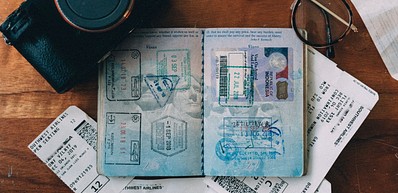
-
![taxi sign inside a taxi in Havana]() Provided by: Louis Renaudineau/unsplash
Provided by: Louis Renaudineau/unsplash

Our travel guides are free to read and explore online. If you want to get your own copy, the full travel guide for this destination is available to you offline* to bring along anywhere or print for your trip.
*this will be downloaded as a PDF.Price
€4,95
Taxi
The guide was updated:There are both private and government-run taxis available for hire in Havana. The difference in price is marginal between the two, and fares need to be agreed on in advance in both cases, even if the car is outfitted with a meter. The yellow and black Ladas tend to be cheaper, and therefore better fit for long-distance travel.
A cheaper and significantly more cheerful way of getting around are the so-called three-seater coco taxis (those of yellow color transport tourists). A similar, but slower option are the two-seater bici-taxis, which are essentially a passenger bike. Note that the safety of using either of the two options has been called into question, even though most rides go incident-free.
Useful Information
Digital Travel Guide Download
Our travel guides are free to read and explore online. If you want to get your own copy, the full travel guide for this destination is available to you offline* to bring along anywhere or print for your trip.
*this will be downloaded as a PDF.Price
€4,95

Travelers visiting Cuba are required to hold a valid passport valid for at least 2 months following their travel date, medical insurance, and proof of return tickets. Proof of sufficient funds to support the stay is also required (50 dollars/day).
Citizens of Namibia can stay in Cuba indefinitely. Citizens of Benin, Bosnia and Herzegovina, Kenya, Malaysia, Montenegro, North Macedonia, Russia, Serbia and United Arab Emirates can stay for up to 90 days. Citizens of Grenada and Saint Vincent and the Grenadines — up to 60 days.
Pasport holders of Antigua and Barbuda, Belarus, Mongolia, Saint Kitts and Nevis, Saint Lucia and Singapore can travel for 30 days, while travelers form Barbados and Dominica are welcome for up to 28 days
The remaining majority of international visitors will need to obtain a Tourist Card, Tarjeta del Turista, that grants permission to stay in Cuba for 30 days and can be extended once for a further 30. The card can be obtained via the airline, travel agent or a Cuban mission abroad.
Citizens of the following countries are not eligible for a Tourist Card and will need to apply for a visa: Afghanistan, Bangladesh, Cameroon, Eritrea, Ethiopia, Ghana, Guinea, India, Iran, Iraq, Nepal, Nigeria, Pakistan, Philippines, Sierra Leone, Somalia, Sri Lanka, Syria, and Yemen. Admission is refused entirely to Kosovo nationals.
Those who fly to Cuba from US airports must purchase a "Pink Tourist Card" which is mainly available in the US and fill an Affidavit form, airlines in the US will be able to provide more information about how to purchase the Pink Tourist Card. These Pink Tourist Cards are needed for everyone flying from the US to Cuba on a direct route. Those who enter Cuba from non-US airports must purchase a "Green Tourist Card", which is often less expensive.
Special regulations apply to Cuban-born foreign citizens, who will need to make visa arrangements for a Cuban visa in advance (via a Cuban Embassy), unless they hold a valid Cuban passport.
Read more

Best Time to Visit
The best time to visit Cuba is probably the dry season, which runs November through April. Cuban tropical climate means that temperatures remain high for the majority of the year, although they can drop significantly between October and March (pack a jacket if you're planning to travel during the period). It's good to have a light water-proof coat when travelling during the rainy season, which falls on the summer months of June through September. Risk of hurricanes is higher from August to October.
Read more

Travel Advice
Internet connection may be difficult to come by in Cuba, but ways of accessing the Internet do exist. In order to get connected, you will need to purchase an Internet card from an ETECSA office and locate an ETECSA WiFi hot-spot or a designated Navigation Room. Card sales are limited to 3 per person regardless of time value, so if you know you'll be needing connection a lot, purchase ones with the highest allowance available (5 hours at the time of writing). ETECSA cards are also sold at hotels and some shops, and some hotels offer Internet access via ETECSA to guests as well. Some international mobile operators offer 3G connection in Cuba, always inquire with your provider as this isn't guaranteed.
Cuban merchandise can be taken out of the country, provided it is for personal use only (as opposed to re-sale). This includes all products made in Cuba, including rum and cigars. Prices for these are normally very similar in downtown Havana and duty-free shops at the airport and cruise terminals.
Cash is used for most transactions in Cuba, and very few places accept card payments. For those that do, there is still risk of your card being declined, especially if it's issued in the USA.
Read more

José Martí International Airport (HAV)
There are several options for reaching the city if you have no tour shuttle transfer pre-arranged. These include renting a car (arrivals areas of terminals 2, 3 & 5; booking in advance is recommended) or taking a taxi (taxi ranks are located just outside the terminals, always agree on the price in advance). Rental cars must be booked in advance.
The average travel time from José Martí International Airport to downtown Havana is 30 minutes, while Varadero can be reached within 2 hours.
Make sure all necessary formalities are in order prior to travel. Medical insurance and proof of financial resources, a passport valid at least 2 months following the date of arrival (more in some cases), as well as appropriate visa documentation and/or Cuban Tourist Card, are all required for everyone entering Cuba.
Read more

Public Transport
There is a hop-on/hop-off bus that operates in Havana, which can be a good compromise between private taxis and public buses. It's mostly geared at tourists, and stops at most major landmarks in Havana.
Although private transportation is recommended, there are several ways of getting around like a local, although some knowledge of Havana goes a long way with those.
One option is flagging down "taxi colectivos," classic old cars that circulate around Havana, marked with a "taxi" sign in the front. They run primarily between the university and Parque Central, and can be stopped nearly anywhere along the way. Flag down a passing "colectivo" and name your destination (a major landmark) to the driver, who will indicate whether or not it's on his route. "Taxi colectivos" are not to be confused with regular private taxis, which charge much more for the rides and deliver you to the desired address.
Public buses are another option. These have fixed routes, designated stops and most often a line of people waiting for one. Exit through the back and keep an eye on your belongings.
If you're in the mood for something different, you might want to consider a tour of Old Havana by horse-drawn carriage. These are, of course, more of an entertainment option than efficient means of getting around.
Read more

Medical
If you take certain medications on a regular basis, it is highly recommended that you bring those along from home in ample supply.
Foreign visitors in need of medical attention are generally referred to the Clínica Central Cira Garcia Hospital. This clinic also has a pharmacy. Medical consultations and treatment at Cuban hospitals generally require payment by a Visa or Mastercard credit card.
Medical help is generally of high quality and readily available in case of emergency. Since health insurance is an obligatory requirement for anyone entering Cuba, all fees and expenses are also accounted for in most cases.
Read more

Post
For important and/or time sensitive mail, it is recommended to use private providers like DHL.
Cuban postage services are notoriously unreliable when sending mail overseas, reports indicating that while some items arrive abroad within weeks, many others never reach their final destination or take many months to arrive. Letters can be mailed at post offices as well as at many hotels via the reception desk.
Read more

Taxi
There are both private and government-run taxis available for hire in Havana. The difference in price is marginal between the two, and fares need to be agreed on in advance in both cases, even if the car is outfitted with a meter. The yellow and black Ladas tend to be cheaper, and therefore better fit for long-distance travel.
A cheaper and significantly more cheerful way of getting around are the so-called three-seater coco taxis (those of yellow color transport tourists). A similar, but slower option are the two-seater bici-taxis, which are essentially a passenger bike. Note that the safety of using either of the two options has been called into question, even though most rides go incident-free.
Read more

Telephone
Your mobile operator may or may not support roaming in Cuba, so inquire with your provider in advance.
ETECSA cards used for Internet connection also work as phone cards, and can be used to make international calls. Calls can be made from blue phone booths, ETECSA offices, and some hotels.
To call abroad from Cuba, dial 119 (the international access code) followed by destination country code and phone number.
A 0 sometimes precedes Cuban phone numbers when calls are made between different provinces. To call landline numbers, dial the provincial code first, followed by the number. From landline to cell phone, dial 0 followed by the number.
To call mobile numbers from a mobile phone within Cuba, dial the number only, which usually starts with 5.
Read more

Electricity
110 or 220 V (the latter supported by some hotels), 60 Hz. International visitors might require a voltage converter. The standard plug type is a US-style two- or three-pin, but some hotels also have European-style plugs. Bring a universal travel adaptor to be prepared for any eventuality.
Read more


